Roots of Mountain Music
What follows is a short history of the major influences that have combined to create mountain music. By using these notes and David Holt’s recordings one can get an overview of history and sounds of this unique music. All music examples are from David’s recordings: I Got A Bullfrog (BF), Reel And Rock (RR) and Grandfather’s Greatest Hits (GGH). The words to the songs follow these notes so that you can sing along if you choose.
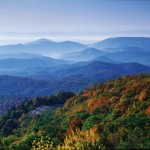 The Southern Mountains has long held the image of a place very slow to change. The mountains create a natural isolation and the people there are notoriously conservative, eager to hold on to tradition. Likewise, when people think of traditional mountain folksongs, they naturally think of an unchanging, static music with few outside influences. But all the major influences that effected other music in America also effected the styles of traditional mountain music. In most parts of America songs of the Civil War, the minstrel and medicine shows, and early vaudeville have long since disappeared. In the Southern Mountains these and other now obscure musical genres are still thriving in the traditional folk music of the region. The Southern Mountains is a microcosm of the musical influences that have occurred throughout the United States in the last two hundred years, but have long since disappeared in other areas of the nation. All the songs we sing here today are versions of songs I have collected within the last 25 years in the Appalachian Mountains and all reflect some aspect of earlier American music.
The Southern Mountains has long held the image of a place very slow to change. The mountains create a natural isolation and the people there are notoriously conservative, eager to hold on to tradition. Likewise, when people think of traditional mountain folksongs, they naturally think of an unchanging, static music with few outside influences. But all the major influences that effected other music in America also effected the styles of traditional mountain music. In most parts of America songs of the Civil War, the minstrel and medicine shows, and early vaudeville have long since disappeared. In the Southern Mountains these and other now obscure musical genres are still thriving in the traditional folk music of the region. The Southern Mountains is a microcosm of the musical influences that have occurred throughout the United States in the last two hundred years, but have long since disappeared in other areas of the nation. All the songs we sing here today are versions of songs I have collected within the last 25 years in the Appalachian Mountains and all reflect some aspect of earlier American music.
What follows is a chronological survey of the musical influences that have changed American music as well as songs from the corresponding historical periods…songs that are still performed today by Southern Mountaineers.
I. BALLADS-The first non-native settlers of the Southern Mountains were English and Scotch-Irish. They brought their old songs and ballads with them. A ballad is a song that tells a story. They were usually sung without any instrumental accompaniment. From the late 1700′s to Civil War instuments in the Southern Mountains were few and far between. During this era, one could find fiddles, three stringed dulcimers, and simple rhythm instruments. After the Civil War the banjo began to be used to back up the singers. You can still find examples of these English folk songs in the mountains today.
SONGS: COO COO -an old English folksong found in Western North Carolina (RR) PRETTY POLLY -Ballads often told a gruesome story. (GGH)
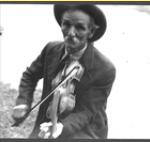
Fiddlin' Bill Hensley
II. FIDDLE TUNES- Early settlers could only bring small instruments with them from Europe. The fiddle, the jaw harp, mouth bow and bones were favorites. They brought a vast repertoire of instrumental tunes from the British Isles. Driven by the energetic square dancing and the banjo, Southerners developed a complicated rhythmic bowing for the old fiddle tunes.
SONGS (notice the very rhythmic fiddle style moving with the banjo): BLACK EYED SUSIE (BF) OLD TIME FIDDLE MEDLEY (GGH)
III. MOUNTAIN SONGS-Early settlers began making up songs about their situation in the New World. They continued to perform most of the older songs but created new ones as well.
SONGS: REEL AND ROCK (RR) MOLE IN GROUND (BF) SAIL AWAY LADIES (RR) FREE LITTLE BIRD (RR)
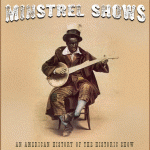 IV. MINSTREL SONGS – Mountain music is a blending of the English and African traditions. One of the first and most important outside influences in mountain music was the minstrel shows. This influential musical phenomenon has largely been ignored because of its racial themes but the minstrel shows helped create American popular music. The minstrel songs were the first real blend of black and white musical ideas. It is this blending of Afro and Anglo-American music which has been the dominant factor in popular music ever since that time. Blues, Jazz, Rock and Roll have all grown out of this unique combination. In the 1830′s there were a few Southern white men interested in learning and presenting the music of the black plantation workers. One of the most important was Joe Sweeney of Appomattox,VA. He learned to play the banjo from black slaves and learned to sing and play their songs. These songs were real folksongs and tell the slave’s point of view of life in the South.
IV. MINSTREL SONGS – Mountain music is a blending of the English and African traditions. One of the first and most important outside influences in mountain music was the minstrel shows. This influential musical phenomenon has largely been ignored because of its racial themes but the minstrel shows helped create American popular music. The minstrel songs were the first real blend of black and white musical ideas. It is this blending of Afro and Anglo-American music which has been the dominant factor in popular music ever since that time. Blues, Jazz, Rock and Roll have all grown out of this unique combination. In the 1830′s there were a few Southern white men interested in learning and presenting the music of the black plantation workers. One of the most important was Joe Sweeney of Appomattox,VA. He learned to play the banjo from black slaves and learned to sing and play their songs. These songs were real folksongs and tell the slave’s point of view of life in the South.
Some give Joe Sweeney credit for adding the 5th or drone string to the banjo, but most likely he just help popularize the originally African instrument. The earliest banjos were made of gourds and Sweeney may have had a hand in making them from a wooden hoop (the forerunner of the modern banjo). The banjo did not arrive in the Southern Mountains until after the Civil War, but has had a tremendous impact on the sound and style of mountain music.
The people of the North became fascinated with the romance of the South

Joe Sweeney popularized the banjo
and the Negro in particular. Many had never seen a Black person before. Minstrel music became a huge success in the North. The typical minstrel band of the 1840-50′s was made up of a fiddle, banjo, bones and tambourine played by 4 white men wearing black face make-up (burnt cork). Many of these musicians had never been south, but learned their music from other white musicians such as Joe Sweeney. Many were gifted songwriters who were able to copy folk styles and create some of our most enduring music. Songs written by professional songwriters during this period include: Oh Susanna, Camptown Races, Buffalo Gals, Yellow Rose of Texas, Turkey in the Straw and Old Dan Tucker. Most people now consider them “folk” songs.
SONG: GLENDY BURKE-(BF) song written by Stephen Foster.
The minstrel shows introduced the nation to the musical influences of blacks, and spread interest in the banjo and bones. The minstrel show songwriters helped solidify an American pop song style. The I, IV, V chord progression and the verse-chorus song form we find in most of our music today started in the mid-1800′s. A few minstrel shows made their way into the Southern Mountains and left behind their songs.
SONG: CAT CAME BACK (BF)-an old minstrel show song.
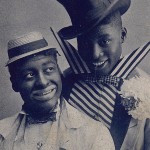
Williams and Walker
Black minstrel troupes sprang up in the North and South, and as was the tradition, put burnt cork on their faces and performed mostly composed songs. These Black minstrel troupes gave people like W.C. Handy, Bessie Smith and Louis Armstrong and many others their start in the entertainment business and allowed white audiences the chance to see real Black talent for the first time. The minstrel shows opened the door for black entertainers to become part of the American show business.
V. CIVIL WAR-The Civil War took young men out of the Southern Mountains for the first time. They were introduced to minstrel songs and instruments like the banjo, bones, harmonica, squeeze box and guitar that they had never seen before.
SONG: DIXIE (GGH)-Dan Emmett was a Northern songwriter, he had never been South when he wrote Dixie in 1858. It was the closing song for his minstrel show. CINDY (BF)
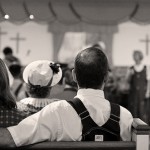 VI. RELIGIOUS MUSIC- From the late 1700′s religious music was sung without harmony. There were rarely any songbooks. The songs had to be powerful melodies with simple words so everyone could sing along. By the mid-1800′s itinerant song leaders and music teachers traveled through the South teaching shaped note singing. Shaped notes were an easy way to learn music without having to learn about sharps and flats. The songbooks were written in four-part harmony. “Sacred Harp” and “Christian Harmony” singing groups can be found today throughout the South and are not part of any denomination. By the turn of the century many inexpensive shaped note songbooks were used in rural mountain churches. The songs had “modern” chordal arrangements and were sung in four part harmony and included more secular themes.
VI. RELIGIOUS MUSIC- From the late 1700′s religious music was sung without harmony. There were rarely any songbooks. The songs had to be powerful melodies with simple words so everyone could sing along. By the mid-1800′s itinerant song leaders and music teachers traveled through the South teaching shaped note singing. Shaped notes were an easy way to learn music without having to learn about sharps and flats. The songbooks were written in four-part harmony. “Sacred Harp” and “Christian Harmony” singing groups can be found today throughout the South and are not part of any denomination. By the turn of the century many inexpensive shaped note songbooks were used in rural mountain churches. The songs had “modern” chordal arrangements and were sung in four part harmony and included more secular themes.
SONG: KEEP ON THE SUNNY SIDE-(BF)-made famous by the Carter family. THIS LITTLE LIGHT OF MINE (BF)-African-American gospel song.
VII. MEDICINE SHOWS- The medicine shows were very influential in
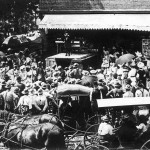
Medicine show
bringing outside music and musical styles to the mountains. From the 1870′s through the l940′s small medicine shows traveled throughout the Southern Mountains selling their home made remedies and drawing a crowd with music. The medicine shows performed a great deal of minstrel show material, which is how many of these songs were introduced to the mountains. The medicine shows were small and could go into very rural communities. They usually consisted of a “Doctor” who made and sold the “medicine”, and at least one entertainer. Very often one of the performers was African-American.
Many of the early stars of commercial country music got their start the medicine shows. People like Uncle Dave Macon, Sam McGee and Roy Acuff all had their start in show business via the medicine show. The following songs were introduced in the mountains through the minstrel or medicine shows and have a great deal of African-American influence.
SONGS: C-H-I-C-K-E-N (BF) PREACHER AND THE BEAR (RR) CRIPPLE CREEK (GGH) RAINCROW BILL (RR) LONG JOHN (BF) YES PAPA (BF)
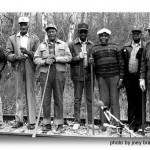
Gandy Dancers kept the tracks in line
VIII. RAILROADS AND AFRICAN-AMERICAN MUSICIANS-The building of the railroads through the mountains brought many Black workers to the Southern Mountains in the 1880′s. Some brought guitars with them. They played a bouncy finger style guitar, a forerunner of the blues, that you can still find today in the playing of Etta Baker from Morganton, NC.
SONG: CORRINA (GGH) JOHN HENRY (GGH)
VIII. PARLOR SONGS OF THE 1890′s-The Civil War gave the American publishing industry a huge boost. Soldiers on the battlefield and folks at home wanted songs about the War to sing. Professional songwriters and publishers (most of whom had been writing minstrel songs) were ready to fill the demand. After the War they turned their attention to creating parlor songs. (The parlor was just beginning to be built onto homes. It was a place to have company and to court your girl friend.)
SONG: WILDWOOD FLOWER-(GGH)-written as a parlor song but made famous by the Carter Family.
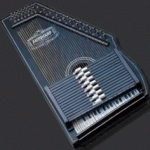
Atutoharp
IX. CATALOG INSTRUMENTS-People needed easy instruments to play in the new parlors. Autoharp, squeeze box, factory made banjos and guitars all made their way into the mountains around the turn of the century when they became available through the Sears and Montgomery Ward catalogs. Tommy Jarrell, the great fiddler from Mount Airy,NC, said there were no guitars around there until the l920′s!
When guitars began to come into use, the music became more chordal. Up until that time the fiddle and banjo just played the melodies. People became more interested in singing songs rather than just playing and listening to instrumental music. The old ballads, which were non-chordal, began to get new arrangements with harmonic chord changes. The newer parlor songs were written with simple chords so they could be easily played on the instruments available through the catalogs.
SONG: DIXIE DARLIN’-(RR)
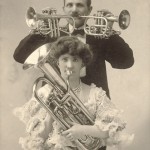 X. VAUDEVILLE- In the late 1880′s vaudeville took over where the minstrel shows left off. Like the medicine shows, early vaudeville relied heavily on the minstrel songs and humor. Many of the early country performers worked the urban vaudeville circuit, learning how to present a professional show. They then toured the Southern Mountains bringing “popular” songs into the backwoods.
X. VAUDEVILLE- In the late 1880′s vaudeville took over where the minstrel shows left off. Like the medicine shows, early vaudeville relied heavily on the minstrel songs and humor. Many of the early country performers worked the urban vaudeville circuit, learning how to present a professional show. They then toured the Southern Mountains bringing “popular” songs into the backwoods.
SONG: WHO BROKE THE LOCK (BF)
XI. RECORDS-The recording industry started in 1888 but ignored rural folk music. In l920, a black singer from New York, Mamie Smith, recorded “Crazy Love”, on the Okeh label. It was the first blues vocal recording. It sold well to black audiences and made the record companies think that there might be a market in recording various other ethnic groups. Most of these 78 rpm recordings were aimed at the northern big city audiences of Poles, Irish, Finnish etc.
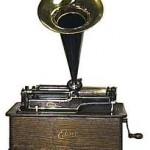 In l922, Polk Brockman, a furniture store owner in Atlanta asked RCA talent scout Ralph Peer to travel to Atlanta to record an entertaining old fiddler named Fiddlin’ John Carson. Peer was skeptical but Brockman said he would buy the first 500 copies himself. “Little Old Log Cabin In The Lane” sold like hot cakes. After Brockman had sold 10,000 copies the recording companies realized there was a market in rural mountain music as well.
In l922, Polk Brockman, a furniture store owner in Atlanta asked RCA talent scout Ralph Peer to travel to Atlanta to record an entertaining old fiddler named Fiddlin’ John Carson. Peer was skeptical but Brockman said he would buy the first 500 copies himself. “Little Old Log Cabin In The Lane” sold like hot cakes. After Brockman had sold 10,000 copies the recording companies realized there was a market in rural mountain music as well.
SONGS: LITTLE OLD LOG CABIN IN THE LANE (GGH)-first commercial country music recording. AIN’T NO BUGS ON ME (BF)-another favorite from Fiddlin’ John Carson.
Ralph Peer and other talent scouts began setting up recording studios in rented hotel rooms in various cities throughout the South to record local musicians. These Northern “Artist and Repertoire” men didn’t understand the music or its appeal so they recorded almost everything. Musicians came out of the mountains to make a record. In the years between 1922 and 1930 thousands of songs were recorded. This was Native American folk music played by amateurs, many of whom were fabulous musicians. The first million seller was recorded by an out of work opera singer, Vernon Dalhart in l927. It’s “Wreck Of The Old 97″ recorded in 1927. The song told the story of an actual train wreck that happened in 1903 in Danville, VA.
SONG: WRECK OF THE OLD ’97 (GGH)
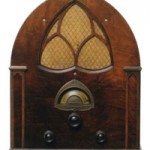 XII. RADIO-Radio had been around since the early l920′s but didn’t have much traditional or old time music. The Grand Ole Opry started in l925 and was huge success. The other radio Jamborees spread old-time music and gave the professional musicians a regular salary and a place to advertise their tours. The Radio made stars out of some local musicians like the Carter Family, and Uncle Dave Macon, the first star of the Grand Ole Opry.
XII. RADIO-Radio had been around since the early l920′s but didn’t have much traditional or old time music. The Grand Ole Opry started in l925 and was huge success. The other radio Jamborees spread old-time music and gave the professional musicians a regular salary and a place to advertise their tours. The Radio made stars out of some local musicians like the Carter Family, and Uncle Dave Macon, the first star of the Grand Ole Opry.
SONG: WABASH CANNONBALL-origionally from the Carter Family. A huge hit for Roy Acuff. (GGH) WHEN THE TRAIN COMES ALONG-from the first “star” of the Opry-Uncle Dave Macon (BF)
Certainly the million watt XERA radio station out of Villa Acuna, Mexico right across the border from Del Rio, Texas had a profound influence on spreading the sound of traditional country music. Started in 1931 by Dr. John Brinkley to promote his goat gland operations and other products the station offered a steady stream of live mountain music. From the Carter Family to J.E. Mainer the sound traditional country music was spread from coast to coast and into Canada setting the stage for a surge in interest in country and folk music in the 1940s, 50s and 60s.
Many consider 1927-1930 were the boom years for old time music. It was the popular country music of the day. Then the depression hit. Record sales were almost nil. When sales began to pick up again, the music had changed. Guitars and Hawaiian guitars were the rage. The fiddle and banjo began to be dropped from commercial music. Country music had become star oriented with the success of Jimmie Rodgers. The crooning singing style had become popular.
By the 1940′s commercial country music had dropped all traces of traditional mountain song and style. It became “hick” music, but continued to be played at home and at square dances.
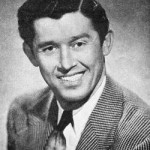
Roy Acuff
A few performers like Roy Acuff and Bill Monroe kept old styles before the public. In 1946 Bill Monroe started a modern variation of old time music by writing new songs and adding more drive and blues to the earlier musical style. Earl Scruggs added the driving 3-finger banjo picking sytle and Bluegrass was born.
The music called Mountain Music, Old-time Music, Hillbilly or Early Country Music is still alive today. Although it no longer enjoys a wide public following, it is played and performed at home and on stage by old-timers as well as young people all around the U.S. who understand its value and love the traditional sounds.
